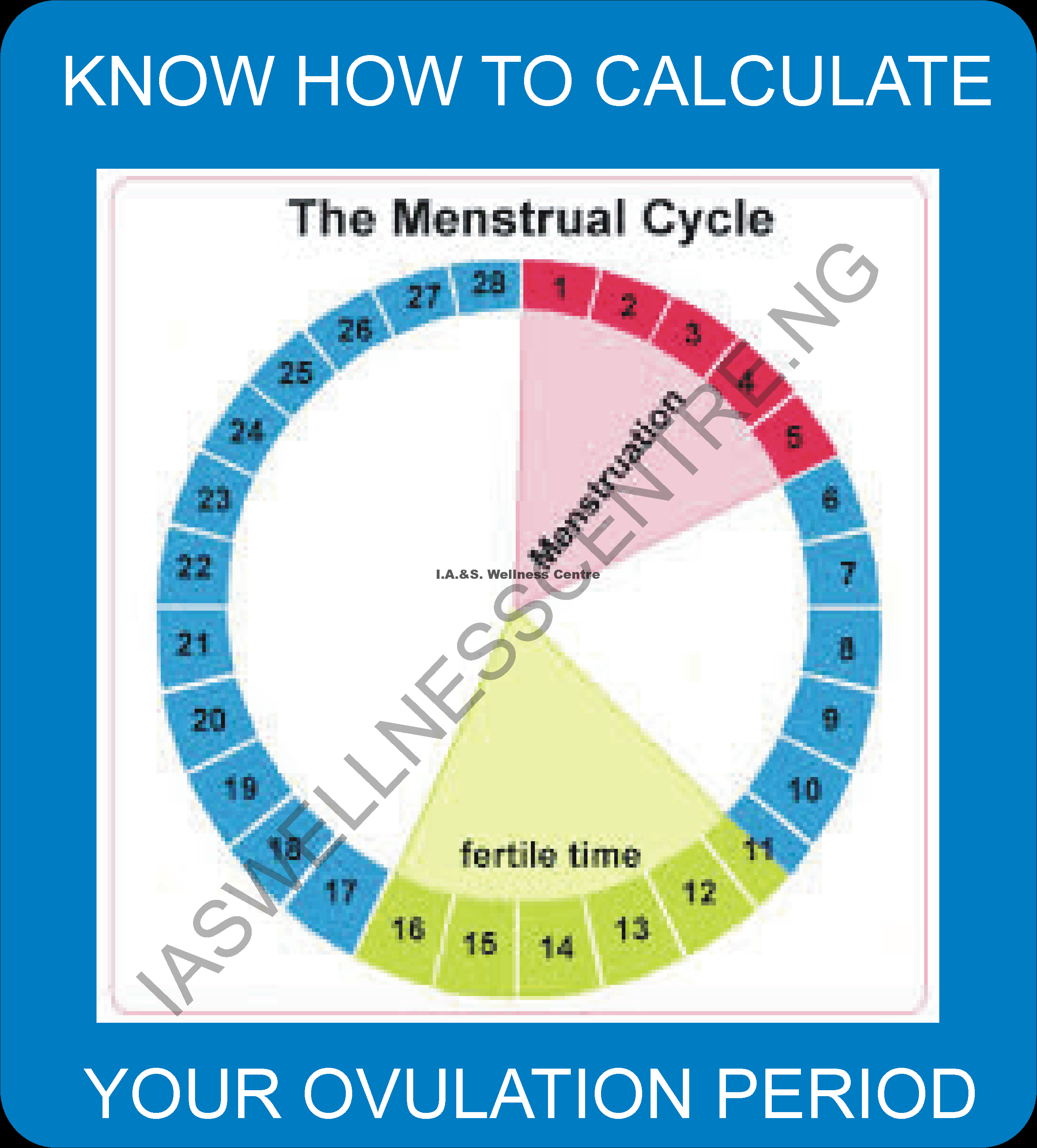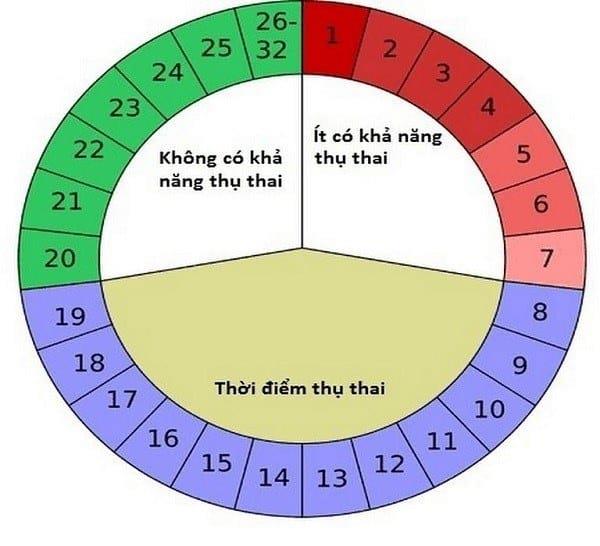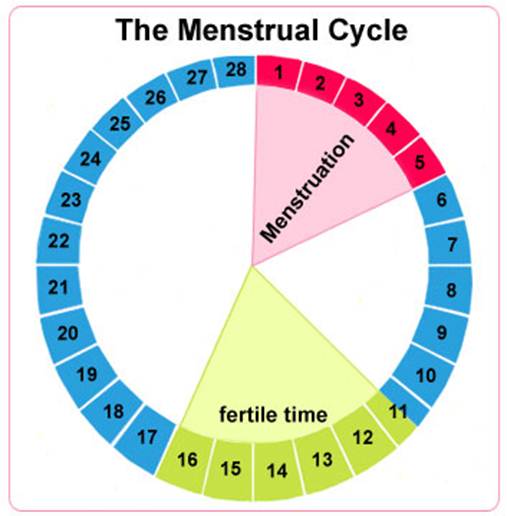Example Ovulation Calculation And Result
Lets take for instance the case of a woman with a cycle length of 31 and the first day of the period August 27th 2014. Her result would be:
Based on your last period starting at August 27, 2014 the results are:
Your next menstrual period is most likely to start on September 27, 2014
You next most fertile days are between September 11, 2014 and September 15, 2014
If you conceive within these most fertile days September 11 – September 15, 2014 your estimated due date will be June 06, 2015.
This is the ovulation calendar for the next 12 months: :
| Period start |
When Is My Most Fertile Period
To get pregnant, it is helpful if you know what your most fertile days are. To find out, you need to know what your menstrual cycle is. An average menstrual cycle lasts 28 days, where day 1 is the first day of your period. Approximately half of that cycle the ovulation takes place and you are fertile. Below you will find a handy schematic representation of your most fertile days.
How Do I Use The Ovulation And Fertility Calculator And Calendar
First, enter the first day of your last menstrual period. Then enter the average length of your menstrual cycles . If you don’t know the exact length of your menstrual cycle or luteal phase, you can leave these at their default values . Try to record your cycle lengths if possible because that will help you to more accurately predict your likely date of ovulation.
What is the difference between the fertility window versus your fertile days?
The “fertility window” or “fertile window” consists of the 5-6 days during the menstrual cycle during which intercourse is most likely to result in pregnancy. You can get pregnant during these days, and your chances of getting pregnant increase the closer you have sex to the day of ovulation. This fertile window extends runs for 6 days starting at 5 days before ovulation until the day of ovulation. Your most fertile days are the 4-5 days before and the day of ovulation.
Calculate your fertile days and your fertility window HERE.
You May Like: How To Relieve Period Cramps In Bed
What Is A Normal Period
A normal period is different for every woman. Each month, one of your ovaries releases an egg. Meanwhile, your uterus gets ready to help your baby grow if that egg gets fertilized. If it does, youâre pregnant. If it doesnât, your body sheds the lining of your uterus through your vagina. Thatâs your period. It happens, on average, every 28 days.
Think about how old you were when you got your first period. Now think about how old you may be when you enter menopause. Your body and life will change a lot from one to the other, right? So does your menstrual cycle.
When it comes to periods, “normal” covers a lot of ground. Use the broad range of factors below as a guide. And remember: The only true normal is what’s normal for you.
How To Use Our Ovulation Calculator

Simply select your usual cycle length from the dropdown box and then choose the date on the calendar when your last period started. With this information, our ovulation calculator estimates your next fertility window .
Based on your results from our ovulation calculator, you can also sign up for handy email reminders, so youll always know your Fertile Window’ each month.
Also Check: What Causes Blood Clots In Period
What Is The Difference Between Ovulation And Fertile Days
‘Ovulation’ is the process of an egg being released from an ovary and this happens 12-16 days before her next period starts.
‘Fertile days’ are the days during a woman’s menstrual cycle, leading up to and including the day of ovulation, when she has the ability to become pregnant if she has unprotected sex.
When are the highest and lowest chances of getting pregnant?
The most fertile days each cycle when you have the best chance of getting pregnant from unprotected sex, are the day of ovulation and the day before these are the 2 days of peak fertility. However, due to the fact that in a woman’s body during her fertile time there are also a few days before this when you also have an opportunity to get pregnant these are the days of high fertility. Outside this fertility window of about 6 days, the chances of getting pregnant are low.
Ovulation Date: How Is Ovulation Calculated How Many Days After My Period Do I Ovulate
So now that we know what it is, how many days after your period can you expect to ovulate? Well, the complicated thing is that everyone is different but usually, you can tell when you will ovulate by the length of your cycle.
The first day of your cycle is the first day of your period, and typically, most people will ovulate anywhere from 7 to 21 days into their cycle. Where exactly ovulation falls within that bracket depends on how long your cycle is. Normal menstrual cycles can range from every 21 days to every 35 days, says Dr. Boyle. The time from ovulation to the next menstrual bleed will always be about 14 days thats generally the same for all women. But the time from the beginning of a period until ovulation is what can vary.
Don’t Miss: If You Get Your Period Are You Pregnant
How To Track Your Period
In just 3 months, you can get a picture of whatâs normal for you by tracking your periods. Keep a record of:
- When your period starts and when it stops
- How light or heavy your flow is
- Whether or not you passed any blood clots
- How frequently you change pads or tampons
- How severe your cramps are
- Changes in mood
Ovulation Calculators Can Only Estimate Dates
Most ovulation calculators are based on the assumption that ovulation occurs 14 days before menstrual bleeding begins, however some research suggests that as few as 10% of women actually ovulate 14 days before menstruation.Even women with regular 28 day cycles do not necessarily ovulate 14 days before their periods begin.
Despite the variable nature of ovulation, an ovulation calculator provides a platform or base to start from if you are seeking to optimize your chances of pregnancy. Ovulation calculator results should be confirmed by using an ovulation test kit or monitor, see here.
Recommended Reading: How Many Days Late Is My Period
Best Ovulation Time For Girl
In the event you want to increase your chances of having a girl, you will need to give the female sperm a little more time to connect with the egg. In this case, mark three to four days before ovulation on your calendar.
Using our fertility calculator to keep track of yours is easy, where all you need to enter is your LMP and your average cycle length. The results from the fertility calculator will help you to plan according, and determine when your little munchkin is due to arrive.
Most Popular
How To Calculate Your Luteal Phase
As discussed above, the luteal phase is now known to be quite variable, even in women with consistent 28 day cycles. But it is still reasonable to begin with the assumption that your luteal phase starts 14 days before menstruation, as long as you bear in mind that this may not be the case for you.
If you don’t know your ovulation date: Assume your luteal phase is 14 days but know this may not actually be so for you.
If you do know your ovulation date: The luteal phase is the number of days from ovulation to the day before your next menstrual period.
Also Check: Do You Have A Period With Nexplanon
How Can We Improve Our Chances To Have A Girl Or A Boy
In addition to calculating your fertile days, this calculator also helps you improve your chances of having a girl or a boy by choosing either girl or boy or by default girl/boy in the drop-down menu. Following our recommendations could improve your chances of having one or the other, though it’s not 100% sure.
For more tips to overcome fertility roadblocks and get pregnant faster, take our Fertility Course via email!
Read More:
Understanding Your Next Menstrual Cycle And Fertilization

If you are trying to get pregnant you need to understand how the menstrual cycle works. The process starts when the thick lining of your womb starts to break up due to the decrease in estrogen and progesterone levels.
Without a sufficient amount of these hormones, your body will shed the lining and it will start to prepare for your next menstrual cycle.
However, if a sperm does make contact with and fertilizes the egg, it will close all pores to prevent more sperms from getting in there. The fertilized egg will stay in the fallopian tube for 3-4 days and then move to the uterus and attach to its wall, staying there for the long haul of pregnancy.
Your body will produce human Chorionic Gonadotrophin or pregnancy hormone right away .
The body will continue to produce the required estrogen and progesterone hormones so that the womb lining will not be shed and the placenta can grow mature enough that it can support the pregnancy.
You May Like: Best Pain Medicine For Period Cramps
Using A Period Calculator
The first thing that the period calculator will ask you is the date of your last period. With so many apps available now, this should be information that is readily available.
And just remember, when calculating your period, you use the first day of your last period. This was the beginning of your cycle.
If you dont know the exact first day, calculate back from the last day however long it lasted, and start tracking now. Especially if you are trying to get pregnant.
Some will use a menstruation calculator to figure out when to expect their periods and when to expect PMS. PMS is due to the change in hormones that cause periods and pregnancy.
When you are pregnant or during your period, these emotional and physical symptoms subside . Some women can then plan to change their diet a few days before they expect PMS and help to alleviate some of the symptoms.
The next piece of information that you will be asked for is the average length of time between your periods. This is the length of the menstrual cycle. Of course, the human body does vary wildly here, and whilst some months there could be 30 days between your period, others it could be as low as 25.
However, you are only after an average here. Being as accurate as possible is important as this will affect the results that you are given which can have a profound effect on when the calculator tells you is the ideal time to try for a child.
How To Calculate Your Next Period & Ovulation Infographic
How Does This Ovulation Calculator Work
This useful health tool can determine the most fertile days and the corresponding due date in case of the fertilization of the egg. In order to do so, you are asked to input the data of your menstrual cycle that is the length and the first day of the latest period.
The result is going to comprise the data for the current cycle, such as the most fertile days as well as the estimated due dates in case of conception, plus an ovulation calendar for the next 12 months that tell exactly when the fertile window is going to be, the estimated due date if needed and the following period start.
Read Also: Dos And Don Ts During Period
How Do I Recognize Ovulation
You can recognize ovulation by the following ovulation symptoms
- Ovulation painOvulation can be felt by pain in the lower abdomen, also called ovulation pain. It is somewhat similar to menstrual pain and may feel like a stabbing pain around your fallopian tubes. This may last for a few hours.
- Rising or lowering body temperatureDuring ovulation, your body temperature will drop about half a degree, but shortly after it will also rise again with about half a degree. By taking your temperature several times a day, you will know when your ovulation has occurred. The only drawback is that by the time you find out, ovulation has most likely already occurred and your most fertile days are already behind you.
- Change in dischargeDuring your fertile days you will notice that the mucus from your cervix changes in structure. During your fertile period, the cervical mucus is transparent and elastic. It feels like it is slippery and wet. Before and after your fertile days, the mucus is creamier and a lot stiffer.
- Sensitive or sore breastsBecause of the change in your hormones, you may experience sore or tender breasts during your ovulation.
- Breakthrough bleedingDuring your ovulation, you may experience light bleeding, also called breakthrough bleeding or ovulation bleeding. On the day of ovulation, you will lose a few drops of blood which may cause a brownish discharge. Breakthrough bleeding of this kind can do no harm, but it does indicate when ovulation occurred.
When To Visit A Doctor
A study depicts that fertility issues affect up to 15% of couples. However, the road to parenthood can sometimes look like a daunting challenge, but right ovulation time may help you to conceive. Theres no specific time to consult a DOCTOR. If you have any of the above-mentioned signs of ovulation, then you should see a doctor tracking your ovulation sequentially.
Read Also: The Open Enrollment Period For Medicare Part B Is
Changes In Cervical Mucus:
When ovulation occurs, the body of a woman produces more amounts of estrogen. Due to secretion of this hormone, the cervical mucus becomes more stretchy, clear and resembles an egg white. It becomes slippery enough to allow sperm to slip and easily reach the egg to unite. When you track ovulation days with this free fertile window calculator, keep checking your mucus to know whether there is good news for you or not.
What Is The Basal Body Temperature Method Of Determining Fertility
Basal body temperature is your temperature at rest as soon as you awake in the morning. A woman’s basal body temperature rises slightly with ovulation. So by recording this temperature daily for several months, you’ll be able to predict your most fertile days.
Basal body temperature differs slightly from woman to woman. Anywhere from 96 to 98 degrees Fahrenheit orally is average before ovulation. After ovulation most women have an oral temperature between 97 and 99 degrees Fahrenheit. The rise in temperature can be a sudden jump or a gradual climb over a few days.
Usually a woman’s basal body temperature rises by only 0.4 to 0.8 degrees Fahrenheit. To detect this tiny change, women must use a basal body thermometer. These thermometers are very sensitive. Most pharmacies sell them for about $10.
The rise in temperature doesn’t show exactly when the egg is released. But almost all women have ovulated within three days after their temperatures spike. Body temperature stays at the higher level until your period starts.
You are most fertile and most likely to get pregnant:
Two to three days before your temperature hits the highest point 12 to 24 hours after ovulation
A man’s sperm can live for up to three days in a woman’s body. The sperm can fertilize an egg at any point during that time. So if you have unprotected sex a few days before ovulation, you could get pregnant.
Read Also: How To Skip Period On Nuvaring
What Are Ovulation Symptoms
Here are the signs you may have when your body releases an egg:
- Your basal or resting temperature falls slightly, then rises again. You can use a special thermometer to check your temperature every morning before you get out of bed. Youâre most fertile 2 or 3 days before your temperature rises.
- Your cervical mucus becomes clearer and thinner with a slippery consistency, like egg whites.
You may also notice:
But these symptoms donât always mean youâre ovulating.
How To Calculate Your Fertile Window Yourself

Formula to Calculate First Day of Fertile Window:Formula to Calculate Last Day of Fertile Window:Cycle Length = Length Between First Days of CycleLuteal Phase = Defaulted to 14 DaysExample:
If you already know your ovulation date, subtract 5 days from your ovulation date . The date you obtain is the start of your fertile window and the day of ovulation is the final day of the window. You may also be fertile 2 days before this.
Also Check: My Period Has Lasted 2 Weeks
Missing Periods For Months:
As we know that a normal menstrual cycle comprises about 27, 28, or 31 days. Now if a woman gets a period in less than 21 days or gets no period, then you must start thinking of the newbie. In such a condition, you must visit your doctor and discuss the condition.
Remember that these ovulation signs are not only the thing to estimate the exact ovulation date, you should visit MEDICAL PRO for the fertility evaluation. Also, you can give try a free online ovulation calculator that enables you to find important fertility dates.
Take Your Prenatal Vitamin
Start popping that prenatal at least a month before you begin trying for a baby. One study showed that women who were taking their prenatal vitamins while undergoing fertility treatments were twice as likely to get pregnant as those who were only taking a folic acid supplement while going through the same treatments. So while it’s not a guarantee that you’ll hit the baby jackpot sooner, it’s definitely worth a shot!
You May Like: Why Do I Have Painful Periods
